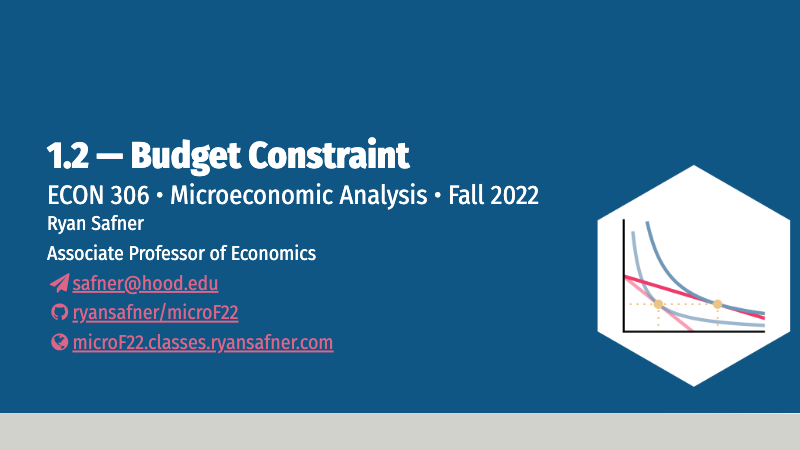1.2 — Budget Constraint — Class Content
Please complete the preliminary survey.
Overview
We are diving right into what is commonly called “Consumer Theory” in textbooks. While our paradigmatic example will indeed be a consumer deciding what goods and services to purchase, please recognize that this model can be applied to just about any decision made by an individual. We should more appropriately describe it as “Rational Choice Theory”. This will take several classes to fully unpack as our formal model of constrained optimization, so today we are only focusing on the constraints using the tool known as the “budget constraint.”
While budget constraints are fairly straightforward, consumer theory often the most “alien” material to students of economics: preferences, indifference curves, and utility functions derived from behavioral axioms. The model we put together—constrained optimization—is borrowed from calculus and engineering. In my opinion, a good chunk of consumer theory, particularly about preferences (next class), is a waste of your time and will give you unnecessary anxiety. It’s perhaps neat for you to see how economists ground all of their models in utility-maximization, but our time is better spent on more productive things. If, however, you plan on going to graduate school for economics or social science, read this chapter, and my online appendices, in great detail.1
Readings
- Ch. 4.3 in Goolsbee, Levitt, and Syverson, 2019
- Bastiat, 1848 “What is Seen and Not Seen”, (Section 1)
- Math Review Guide
Now that we are picking up the intensity and working with some models (many will be new to you at first), I recommend looking at the textbook readings before each class.
If you are following the textbook, we are going a bit out of order in two ways. It goes straight into (a review of principles, really) supply & demand in Chapters 1-3. We will ultimately get to supply and demand, but if you trust me, by the time we do later this semester, you will have a much richer understanding and appreciation for them, having understood how they represent the decisions by optimizing individuals as buyers and sellers.
It begins “Consumer Theory” as chapter 4. It also stars with the “newer” and “weirder” stuff first — indifference curves and utility functions, and then teaches budget constraints second. I will go in the opposite order to slowly acclimate you from familiar territory (linear equations) into newer tools and concepts (nonlinear functions, multivariate functions, optimization, etc). This is also a good time to review my Math Review Guide for next week.
The Bastiat reading is perhaps one of the greatest economic parables ever written, and demonstrates the importance of opportunity cost in clear thinking (especially about policy).
Optional/Referenced Readings
Practice
Today we will be working on practice problems. Answers will be posted later on that page.
Assignments
Preliminary Math Survey Due
Please take the preliminary survey on your math background. This will help us all have a productive semester together.
Appendix
See the online appendix for today’s content:
Slides
Below, you can find the slides in two formats. Clicking the image will bring you to the html version of the slides in a new tab. The lower button will allow you to download a PDF version of the slides.
You can type h to see a special list of viewing options, and type o for an outline view of all the slides.
I suggest printing the slides beforehand and using them to take additional notes in class (not everything is in the slides)!
Footnotes
And see this tweet for an 100% accurate example of what you can expect in a common Ph.D textbook discussing preferences.↩︎
